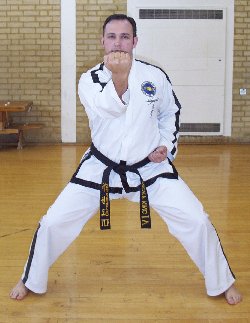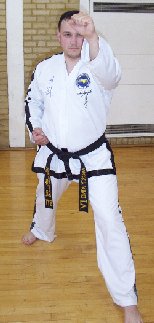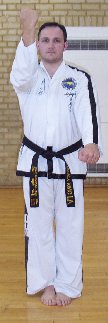Established Since 1993
Kings Tae Kwon-Do
You're Born to be a Black Belt
Types of Block
Blocks and other movements can be classified differently depending on the orientation of the body with regard to the target and the position of the blocking tool with regard to the lateral line of the body. Below are three examples of different types of block:
There is a photograph of Mr. King performing an example of each type block. There are also bullet points describing the block and text from the encyclopaedia of Tae Kwon-Do in italics that gives more information.

|
Front Block (ap makgi)
If the body is full facing the target and the blocking tool stays at the centre of the defenders body, regardless of the blocking tool, stance used or previous position of the opponent, the block is called a front block. It is mainly performed with the outer forearm, knife-hand twin-palm and palm though occasionally X-fist, X-knife-hand and reverse knifehand are used. The front block is performed in the form of an inward block in all cases except X-fist, X-knife-hand and twin-palm. Be sure to bring the finger belly either to the side fist or forearm when executing a low block. |

|
Side Block (yop makgi)
|

|
Side Front Block (yobap makgi)
|
Links to ITF other Websites
- United Kingdom Global Tae Kwon-Do
- ITF Vienna website
- All Europe Tae Kwon-Do Federation homepage
- Burbage Tae Kwon-Do Club
- United Kingdom Tae Kwon-Do Association Web Site
- Irish United Taekwon-do Federation (IUTF)
- International Taekwon-Do Foundation of New Zealand
- United States Taekwon-Do Federation (USTF)
- Centro Argentino de Taekwon-Do (ITF)
- Sonkal Website
- General Choi Hong Hi Website
- ITF England website
- Com-Do Inc. (Producers of the Legacy CD-Rom and Videos)